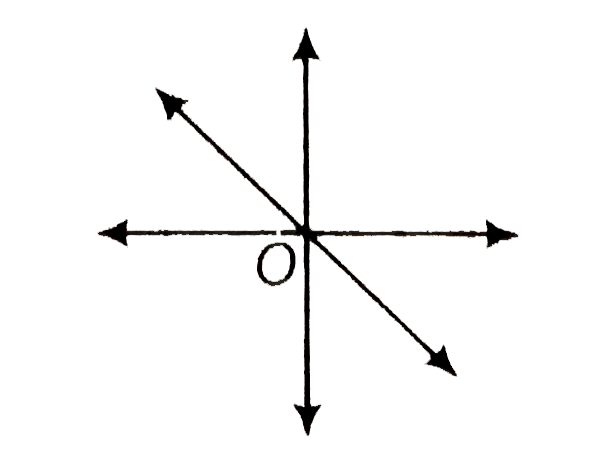State which of the following statements is true of false.
(i) If x<yandb<0, then xb<yb.
(ii) If xy>0, then x>0andy<0
(iii) If xy>0, then x<0andy<0
(iv) If xy<0, then x<0andy<0
(v) If x<−5andx<−2, than x∈(−∞,−5)
(vi) If x<−5andx>2, then x∈(−5,2)
(vii) If x>−2andx<9,then x∈(−2,9)
(viii) If |x|>5, then x∈(−∞,−5)∪[5,∞)
(ix) If |x|≤4, then x∈[−4,4]
(x)Graph of x<3is

(xi) Graph of x≥0 is

(xii) Graph of y≤0 is

(xiii) Solution set of x≤0andy≤0 is

(xiv) Solution set of x≥0andy≤1 is

(xv) Solution set of x+y≥0 is

(i) If x<yandb<0
⇒xb>yb
Hence, statement (i) is false.
(ii) If xy>0, then 0,y>0orx<0,y<0.
Hence, statement (ii) is true.
(iii) If xy>0, then x<0andy<0.
Hence, statement (iii) is true.
(iv) If xy<0⇒x<0,y>0orx>0,y<0.
Hence, statement (iv) is false.
(v) if x<−5andx<−2, then
x∈(−∞,−5)
Hence, statement (v) is true.
(vi) If x<−5andx>2, then x have no value.
Hence, statement (vi) is false.
(vii) If x>−2andx<9, then x∈(−2,9).
Hence, statement (vii) is true.
(viii) If |x|>5, then either x<−5orx>5.
⇒x∈(−∞,−5)∪(5,∞)
Hence, statement (viii) is false.
(ix) If |x|≤4, then
−4≤x≤4
⇒x∈[−4,4]
Hence, statement (ix) is true.
(x) The given graph represents x≤3.
Hence, statement (x) is false.
(xi) The given graph represents x≥0.
Hence, statement (xi) is true.
(xii) The given graph represent y≥0.
Hence, statement (xii) is false.
(xiii) Solution set of x≥0andy≤0 is

Hence, statement (xiii) is false.
(xiv) Solution set of x≥0andy≤1 is

Hence, statement (xiv) is false.
(xv) The given graph represents x+y≥0.
Hence, statement (xv) is correct.
Topper's Solved these Questions
- LINEAR INEQUALITIESBOOK - NCERT EXEMPLARCHAPTER - LINEAR INEQUALITIESEXERCISE - Long Answer Type Question
6 Videos
- LIMITS AND DERIVATIVES BOOK - NCERT EXEMPLARCHAPTER - LIMITS AND DERIVATIVES EXERCISE - FILLERS
4 Videos
- MATHEMATICAL REASONING BOOK - NCERT EXEMPLARCHAPTER - MATHEMATICAL REASONING EXERCISE - OBJECTIVE TYPE QUESTIONS
21 Videos
Similar Questions
State True or False: If bxy<0 and byx<0 then ‘r’ is >0
View SolutionWhich of the following statements is true for the function f(x)={√x,x≥1x3,0≤x≤1x33−4x,x<0 It is monotonic increasing ∀x∈R. f′(x) fails to exist for three distinct real values of x. f′(x) changes its sign twice as x varies from −∞→∞. The function attains its extreme values at x1andx2, such that x1andx2>0
View Solution
Knowledge Check
The solution set of x+3>0,2x<14 is:
A[−3,7]B(−3,−7)C(−3,7)D[3,−7].Given f(x)={2x,x<0,0,x≥0}then f(x) is
Adiscontinuous and not differentiable at x = 0Bcontinuous and diferentiable at x = 0Cdiscontinuous and differentiable at x = 0Dcontinuous and not differentiable at x = 0
In which of the following cases, the function f(x) has vertical tangent at x = 0 ?
(v) f(x)={0, if x<01, if x≥0
View SolutionWhat is the sign of cos(x2)–sin(x2) when (i)0<x<π4 (ii) π2<x<π
View SolutionThe absolute value of |x−2|+|x+2|, if 0<x<2 is
View SolutionSolve each of the following linear programming problems by graphical method. Maximize Z=x+y Subject to −2x+y≤1 x≤2 x+y≤3 x,y≥0
View SolutionFigure 2.23 shows the graph of the polynomial f(x)=ax2+bx+c for which (FIGURE) (a) a⟨0, b⟩0 and c>0 (b) a<0,b<0andc>0 (c) a<0, b<0 and c<0 (d) a>0, b>0 and c<0
View SolutionSolve the following problem graphically:Minimise and Maximise Z=3x+9y . . . (1)subject to the constraints: x+3y≤60 . . . (2) x+y≥10 . . . (3) x≤y . . . (4) x≥0,y≥0 . . . (5)
View Solution
